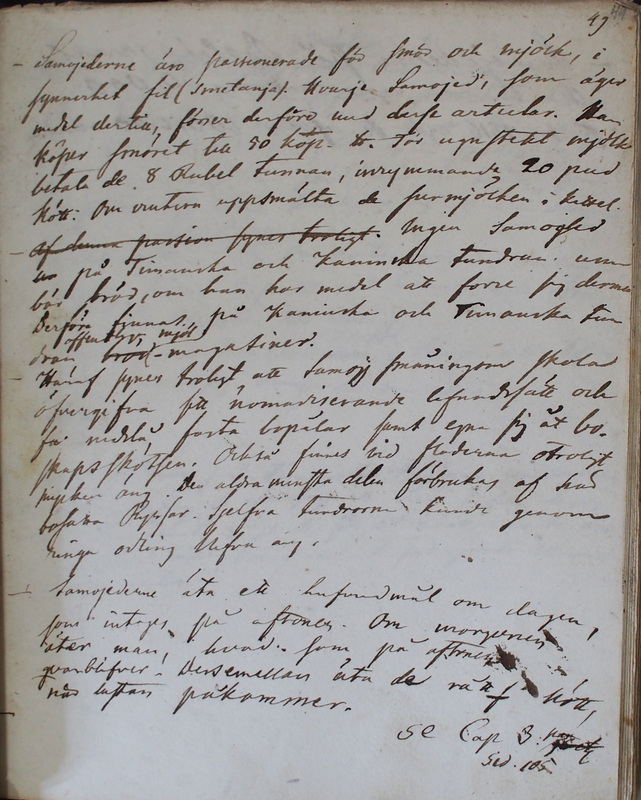Ethnographiska, historiska och statistiska anmärkningar. 049
Title
Description
| Samojederne äro passionerade för smör och mjölk, i synnerhet fil (smetanja). Hvarje Samojed, som äger medel dertill, förer derföre med desse articlar. Han köper smöret till 50 kop. För ugnstekt mjölk betala de 8 Rubel tunnan, inrymmande 20 pud kött. Om vintern uppsmälta de surmjölken i kittel |
The Samoyeds are passionate about butter and milk, especially smetana. Every capable Samoyed brings these articles with him. He buys butter for 50 kopecks. For oven-baked milk they pay 8 roubles per barrel, which can hold 20 pud of meat. In winter, they melt sour milk in a cooking pot. |
| Af denna passion synes tråkigt. Ingen Samojed på Timanska och Kaninska tundran um- bär bröd, om han har medel att forse sig dermed. Derföre finnas på Kaninska och Timanska tund- brödoffentlig mjöl-magasiner. |
The Timan and Kanin Samoyeds cannot do without bread, if they can obtain it. Therefore, there are public flour shops in the Kanin and Timan tundras. |
| Häraf synes troligt, att Samojj[eder]. småningom skola öfvergifva på nomadiserande lifnadssätt och få nedslå fasta bopålar samt egna sig åt bo- skapsskötsen. Också finnes vid floderna otroligt mycket äng. Den aldra minsta delen förbrukas af här bofasta Ryssar. Sjelfva tundrorna kunde genom ringa odling blifva äng. |
On this evidence, it seems probable that the Samoyeds will eventually abandon the nomadic way of life and resign themselves to permanent housing and indulge in cattle farming. In addition, there is an incredible abundance of meadows by the rivers. The Russians living here use only the smallest part of these. The tundra itself could become a meadow through a little cultivation. |
|
Samojederne äta ett hufvudmål om dagen,
som intages på aftonen. Om morgonen äter man hvad som på aftonen qvarblifver. Dessemellan äta de rått kött, när lusten påkommer.
This corresponds somewhat to Chomič (1966: 139), according to whom one usually eats three times a day. The meal is cooked for lunch and dinner, and tea is always served. More recent ethnographies tend to give a similar picture; Stammler notes that spices and sauces such as mustard and ketchup have entered the tundra kitchen (Stammler 2005: 91–99).
Se cap. 3: kött Sid. 105 |
The Samoyeds eat one main meal a day, which is eaten in the evening. In the morning they eat what was left in the evening. In between these meals they eat raw meat when they get hungry. See Chapter 3: meat, page 105. |

